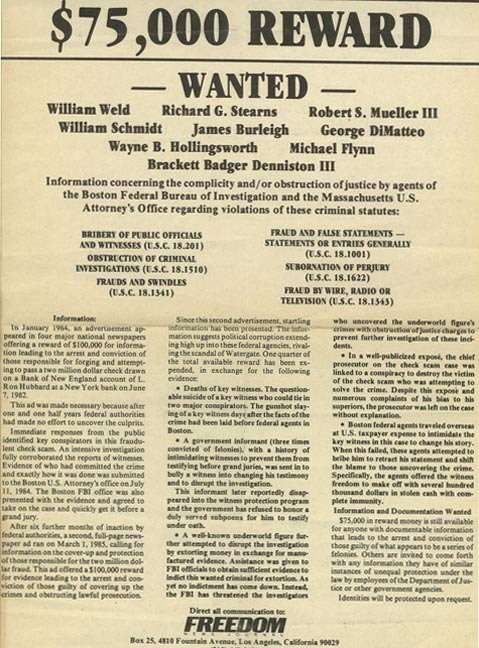
An ad put out by the Scientology organization in 1986 |
This article originally appeared in the June 3. 1986 issue of the Boston Phoenix
Back on the morning of June 7, 1982, a man walked into the New York branch of the Middle East Bank on the 25th floor of a Madison Avenue office building and tried to deposit a $2 million check. The man, a native of the United Arab Emirates, left without completing the transaction.
The check, written on an E.F. Hutton money-market account handled by the Bank of New England, was a forgery. Although attempted bank fraud of that ilk is not particularly unusual, this particular incident triggered a complex, bizarre and, at times, vicious battle that shows no sign of abating nearly four years later.
The forged check had been written on the account of L. Ron Hubbard, reclusive founder of the Church of Scientology, who died last January. No one has ever been charged publicly with that attempted fraud, which Scientologists have come to regard as the most brazen of assaults on their religion and church. Some Scientologists believe that Boston lawyer Michael J. Flynn -- who has made something of a career out of suing the Church of Scientology -- was behind the scam.
Flynn vehemently denies any involvement with the bogus Hubbard check. And indeed, the accusation has always seemed preposterous. For even if the Hubbard check had been successfully deposited, it is far more likely that the Bank of New England (or, to be more precise, the bank’s insurance company), and not L. Ron Hubbard, would have lost the money.
To gather evidence in the case, Scientologists offered a reward of up to $100,000 for information leading to the conviction of those who had tried to pass the bogus Hubbard check. And that reward offer produced results, though not necessarily what the Scientologists wanted. Among those who got portions of the reward were a con artist known as the Prince of Fraud, another man reputed to be an organized-crime figure, and a third character, who has since admitted involvement in the check scam -- Larry Joseph Reservitz.
Larry Reservitz is a former lawyer who was disbarred for bilking insurance companies on bogus car accidents and for cheating a client out of a fee. He then moved on to other vocations: forger, cardshark, Las Vegas gambler, friend to politicians and professional athletes, black-marketer, international fugitive, and, in his latest incarnation, a protected government witness.
Reservitz is at the fulcrum of a complex tale of intrigue that has only begun to unfold in federal court. Much remains unknown, though it is clear that Scientologists, the FBI, reputed organized-crime figures, and private investigators have all engaged in some labyrinthine scheming. But in many ways it is unclear who is the victim and who is the culprit; who is the con man and who is the conned; who is investigating whom, for what crimes, and -- finally -- why.
The Scientologists have claimed in court documents that one man involved in the scheme was Ala Fadili Al Tamimi, a native of the United Arab Emirates, who blazed an unparalleled trail of fraud across Massachusetts before jumping bail, according to charges still pending against him. Scientologists say that they gave him $25,000 for writing an affidavit -- a move which is technically legal, if risky -- in which he claimed he had helped mastermind the bogus check scheme along with Flynn. When the Boston Globe, in July 1984, wrote about those allegations, Larry Reservitz got a laugh at the Scientologists’ pursuit of Flynn, who, Reservitz said, had nothing to do with the check. Michael Flynn didn’t laugh. He sued the Globe for libel, a case that is still pending.
(A federal grand jury, however, does not doubt that Tamimi had some involvement with the bogus Hubbard check. Indeed, court records in Germany, where he is being held, indicate that Tamimi was secretly indicted in Boston last November for attempting, along with his brother, to pass two bogus checks at the Madison Avenue Middle East Bank between April and June of 1982. The indictment remains sealed, apparently pending Tamimi’s extradition to this country on old fraud charges unrelated to this case. Tamimi recently was extradited from a prison in Italy to a prison in Germany, as he makes the rounds of atonement for a career of fraud.)
The latest chapter in the bogus-check case was made public last week: reputed organized-crime figure George T. Kattar, 67, of Methuen, and defrocked lawyer Harvey Brower, 49, of Swampscott, were indicted last week on fraud and extortion charges. The grand jury claims that Brower and Kattar offered to provide information to Scientologists about the bogus Hubbard check for $100,000. Brower and Kattar allegedly bilked the Scientologists out of an initial down payment of $33,333, using “threatened force, violence and fear.” The indictment says Brower and Kattar gave Scientologists inaccurate information about the check, but the indictment doesn’t detail the nature of that information.